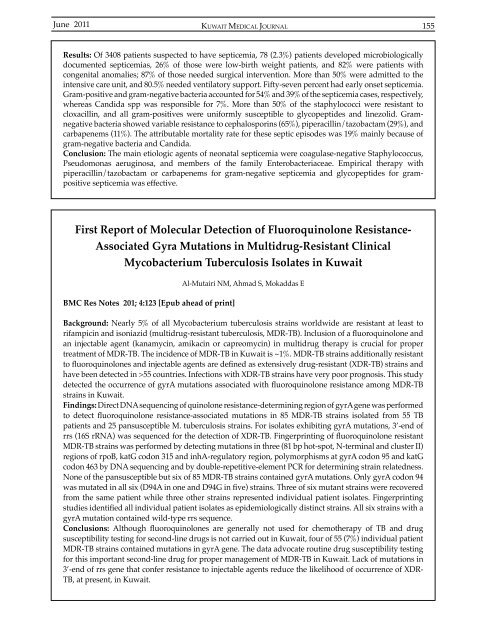Vol 43 # 2 June 2011 - Kma.org.kw
Vol 43 # 2 June 2011 - Kma.org.kw
Vol 43 # 2 June 2011 - Kma.org.kw
Create successful ePaper yourself
Turn your PDF publications into a flip-book with our unique Google optimized e-Paper software.
<strong>June</strong> <strong>2011</strong><br />
KUWAIT MEDICAL JOURNAL 155<br />
Results: Of 3408 patients suspected to have septicemia, 78 (2.3%) patients developed microbiologically<br />
documented septicemias, 26% of those were low-birth weight patients, and 82% were patients with<br />
congenital anomalies; 87% of those needed surgical intervention. More than 50% were admitted to the<br />
intensive care unit, and 80.5% needed ventilatory support. Fifty-seven percent had early onset septicemia.<br />
Gram-positive and gram-negative bacteria accounted for 54% and 39% of the septicemia cases, respectively,<br />
whereas Candida spp was responsible for 7%. More than 50% of the staphylococci were resistant to<br />
cloxacillin, and all gram-positives were uniformly susceptible to glycopeptides and linezolid. Gramnegative<br />
bacteria showed variable resistance to cephalosporins (65%), piperacillin/tazobactam (29%), and<br />
carbapenems (11%). The attributable mortality rate for these septic episodes was 19% mainly because of<br />
gram-negative bacteria and Candida.<br />
Conclusion: The main etiologic agents of neonatal septicemia were coagulase-negative Staphylococcus,<br />
Pseudomonas aeruginosa, and members of the family Enterobacteriaceae. Empirical therapy with<br />
piperacillin/tazobactam or carbapenems for gram-negative septicemia and glycopeptides for grampositive<br />
septicemia was effective.<br />
First Report of Molecular Detection of Fluoroquinolone Resistance-<br />
Associated Gyra Mutations in Multidrug-Resistant Clinical<br />
Mycobacterium Tuberculosis Isolates in Kuwait<br />
BMC Res Notes 201; 4:123 [Epub ahead of print]<br />
Al-Mutairi NM, Ahmad S, Mokaddas E<br />
Background: Nearly 5% of all Mycobacterium tuberculosis strains worldwide are resistant at least to<br />
rifampicin and isoniazid (multidrug-resistant tuberculosis, MDR-TB). Inclusion of a fluoroquinolone and<br />
an injectable agent (kanamycin, amikacin or capreomycin) in multidrug therapy is crucial for proper<br />
treatment of MDR-TB. The incidence of MDR-TB in Kuwait is ~1%. MDR-TB strains additionally resistant<br />
to fluoroquinolones and injectable agents are defined as extensively drug-resistant (XDR-TB) strains and<br />
have been detected in >55 countries. Infections with XDR-TB strains have very poor prognosis. This study<br />
detected the occurrence of gyrA mutations associated with fluoroquinolone resistance among MDR-TB<br />
strains in Kuwait.<br />
Findings: Direct DNA sequencing of quinolone resistance-determining region of gyrA gene was performed<br />
to detect fluoroquinolone resistance-associated mutations in 85 MDR-TB strains isolated from 55 TB<br />
patients and 25 pansusceptible M. tuberculosis strains. For isolates exhibiting gyrA mutations, 3’-end of<br />
rrs (16S rRNA) was sequenced for the detection of XDR-TB. Fingerprinting of fluoroquinolone resistant<br />
MDR-TB strains was performed by detecting mutations in three (81 bp hot-spot, N-terminal and cluster II)<br />
regions of rpoB, katG codon 315 and inhA-regulatory region, polymorphisms at gyrA codon 95 and katG<br />
codon 463 by DNA sequencing and by double-repetitive-element PCR for determining strain relatedness.<br />
None of the pansusceptible but six of 85 MDR-TB strains contained gyrA mutations. Only gyrA codon 94<br />
was mutated in all six (D94A in one and D94G in five) strains. Three of six mutant strains were recovered<br />
from the same patient while three other strains represented individual patient isolates. Fingerprinting<br />
studies identified all individual patient isolates as epidemiologically distinct strains. All six strains with a<br />
gyrA mutation contained wild-type rrs sequence.<br />
Conclusions: Although fluoroquinolones are generally not used for chemotherapy of TB and drug<br />
susceptibility testing for second-line drugs is not carried out in Kuwait, four of 55 (7%) individual patient<br />
MDR-TB strains contained mutations in gyrA gene. The data advocate routine drug susceptibility testing<br />
for this important second-line drug for proper management of MDR-TB in Kuwait. Lack of mutations in<br />
3’-end of rrs gene that confer resistance to injectable agents reduce the likelihood of occurrence of XDR-<br />
TB, at present, in Kuwait.
















